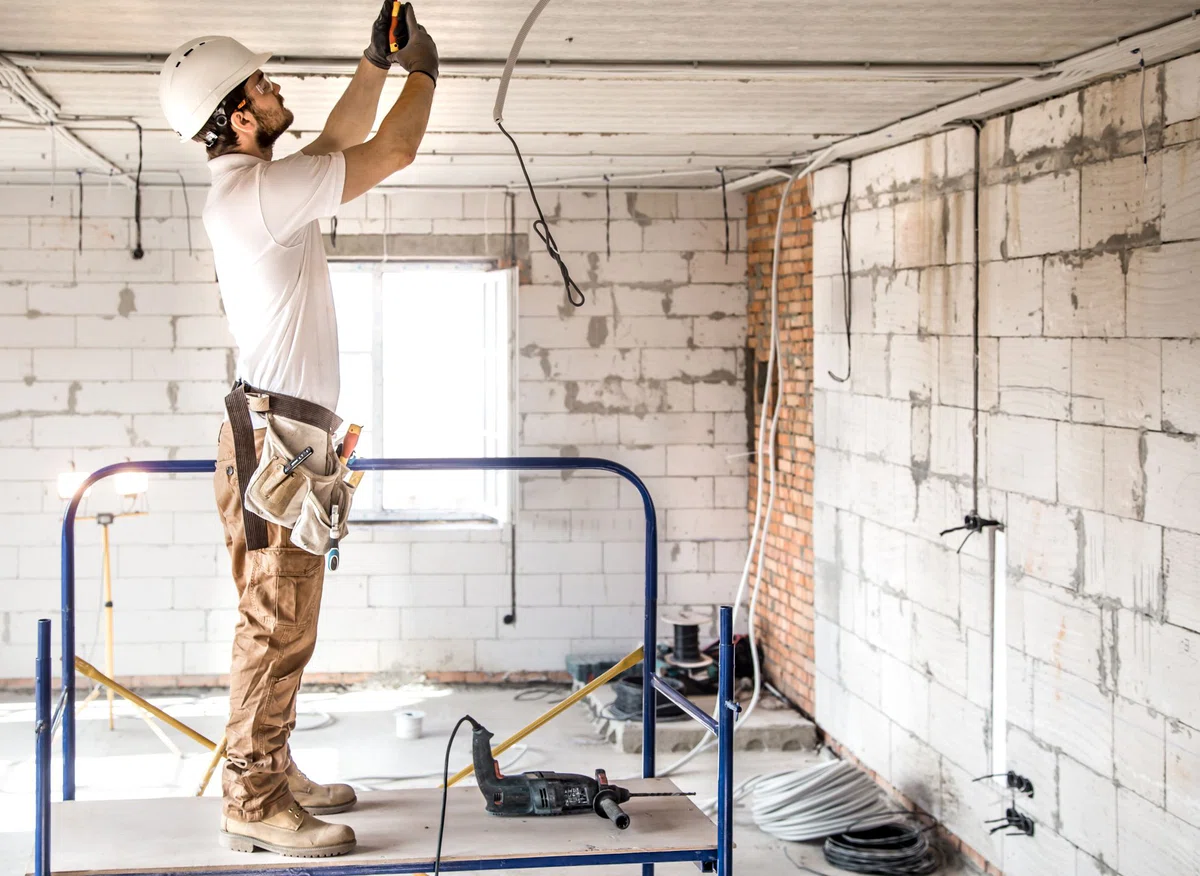
Finishing work: creating stylish interiors and improving the appearance of premises
We understand how finishing works give the room an attractive look and create harmony in the interior. Learn about different finishes and materials. Useful information for successful repair and design. ⭐ Go to the site for the full version of the article.
Content
- What is the role of finishing works in the renovation process?
- Exterior finishing: importance and types of works
- Interior finishing of premises: variety of types of works
- The main stages of construction and finishing works
- The process of facing surfaces: creating beautiful and durable finishing coatings
- Stages of electrical installation
- Stages of wallpapering
- Stages of painting
- Plumbing works
- Flooring laying process
- Finishing of premises: the last stage of construction and finishing works
- Frequently asked questions
- 🔹 What types of finishing works are there?
- 🔹 What is ceiling installation?
- 🔹 What does wall finishing include?
- 🔹 What is tile installation?
- 🔹 What does flooring mean?
- 🔹 What does installing doors involve?
- 🔹 What work is included in installing plumbing and lighting fixtures?
- 🔹 How long does the finishing work last?
- 🔹 How important is the quality of the finishing work?
It is impossible to make a quality repair, provide heat and sound insulation without finishing works. Finishing of premises is one of the most important stages of repair. The article describes in detail how you can perform finishing on your own or with the help of a repair team.
Finishing work is the final stage, which creates coziness and beauty in the room. The article provides information about the different types of finishing work, such as wallpaper, plastering and painting surfaces. In addition, it emphasizes the importance of taking into account various nuances when performing finishing.
What is the role of finishing works in the renovation process?
Finishing works play an important role in completing the renovation and making the room look presentable. They can be divided into two main groups according to their purpose.
- The first group is aesthetic purposes, which are aimed at improving the appearance of the room. By carrying out finishing works, it is possible to create an attractive interior design, emphasize the style and character of the room. This includes the selection of finishing materials such as wallpaper, paint, tiles, flooring and other elements that will help create the desired atmosphere and harmony in the room. Colors, textures and decorative elements can also be used to create a unique and attractive interior.
- The second group is protective purposes, which are related to ensuring the durability and preservation of surfaces in the room. Finishing works may include the use of special materials that have properties of protection against environmental influences, corrosion and decay. For example, wall and ceiling coatings may be designed to protect against moisture, dirt or mechanical damage. In addition, the use of special materials for floors and the treatment of wooden surfaces can help prevent wear and damage.
Finishing works are carried out both indoors and outdoors. Interior finishing includes work in residential, commercial and public spaces where it is important to create a comfortable and functional environment. This may include treating walls, ceilings, floors, installing doors and windows, and carrying out lighting and electrical work. Exterior finishing, on the other hand, is concerned with the external appearance of a building or structure, where the use of special finishing materials and techniques can achieve the desired visual effect and protect the building from weather conditions and other external factors.
Carrying out quality finishing work requires skill, experience and knowledge, so it is often advisable to contact professional repair teams or specialists. They will be able to provide expert opinion, help select suitable materials and carry out the work in accordance with the requirements and expectations of the client.
Exterior finishing: the importance and types of work
When it comes to the exterior finishing of the building, special attention is paid to protecting the surfaces from the unfavorable effects of natural factors. At this stage, various works are carried out, such as installing finishing panels, plastering walls, tiling the house and applying finishing materials.
Each of the types of finishing works has its pros and cons. For example, plastering is a more budget option, involving the use of a special solution with synthetic additives. These additives make the finishing material resistant to moisture and temperature changes. However, plaster can cause certain problems in achieving perfectly even walls. Even small cracks and damage can be noticeable and spoil the overall appearance.
At the same time, finishing panels offer reliable surface protection and do not require complicated pre-treatment. They can be made from a variety of materials such as wood, metal, plastic or composite materials. This provides a variety of finishing options and the ability to choose the right style and design for the building.
However, exterior finishing does not only include the installation of finishing materials, but also requires proper preparation of surfaces and the selection of suitable protective coatings. For example, the use of special impregnations and paints can provide additional protection against moisture, ultraviolet radiation and other external factors.
It is important to note that the choice of a particular type of exterior finish depends on many factors, such as climatic conditions, budget, design preferences and requirements for durability and aesthetic appearance. When choosing a suitable option, it is recommended to contact professionals who will be able to assess the specific requirements and offer the best finishing option.
Interior finishing: a variety of types of work
Interior finishing works are carried out in order to provide heat protection, soundproofing and complete preparation of premises for subsequent use for residential or commercial purposes. However, when carrying out such works, it is necessary to pay special attention to safety, choosing only environmentally friendly and certified materials.
Strictly following the top-down principle, interior finishing starts from the ceiling and gradually progresses to the floor. This allows you to ensure consistency and quality of work, creating a harmonious atmosphere in the room. Let's consider some of the main types of interior finishing works, which give the room a finished look and provide functionality.
- Ceiling Finishing: Includes leveling the ceiling surface, applying primer, painting, stretch ceilings or installing decorative elements such as moldings or suspended ceilings. Special materials can also be used to improve soundproofing and thermal insulation.
- Wall finishes: Interior walls can be finished in a variety of ways, including wallpaper, painting, tiling, decorative panels or wood trim. The choice of materials and finishing methods depends on design preferences, room functionality and aesthetic requirements.
- Flooring: Interior finishing includes the selection and installation of flooring such as laminate, parquet, carpet, tile or linoleum. In addition, subfloor preparation, leveling and installation of baseboards.
- Doors and Windows: Interior doors and windows are also an important element of the finish. The choice of styles, materials and finishes for doors and windows can have a significant impact on the overall appearance of the room and provide the right level of insulation and security.
- Bathroom and Kitchen Finishes: Bathrooms and kitchens require special attention in interior finishes. It is important to use moisture-resistant and easy-to-clean materials for wall and floor cladding, as well as to install quality sanitary fixtures and accessories.
When performing interior finishing works, it is necessary to take into account the individual features of the room, functional requirements and aesthetic preferences. In addition, it is important to cooperate with experienced professionals to ensure high quality work and durable results.
Main stages of construction and finishing works
Preliminary preparation of the room: Before starting the rough finishing, it is necessary to remove all furniture and other items that may interfere with the work. Depending on the scope of repair, it may be necessary to completely vacate the premises or transfer things to neighboring rooms.
-Plastering: This type of work is necessary to eliminate irregularities and defects in the surface of the walls. The walls must be prepared and then leveled with plaster before starting the work.
-Masonry work: This includes the assembly and installation of partitions, fireplaces and other structures made of various materials.
-Gypsum plasterboard works: An important stage of rough finishing, including the installation of niches, soffits and suspended ceilings made of gypsum plasterboard (GKL).
-Painting: Includes priming and polishing of surfaces, as well as the application of putty. This stage gives the walls a smooth surface ready for further finishing.
-Sanitary works: They include installation of sewerage and water supply systems, preparation of space for installation of sanitary appliances such as bathtubs, toilets, shower cabins, as well as their installation.
-Electrical works: This includes drilling of walls for laying of communications, conducting of electric cables and preparation of places for installation of sockets and switches.
-Glazing: This stage can be included in the rough finish depending on the requirements of the project. Glazing the room allows for natural light and visual space.
The duration of rough-in depends on the scope of work and the complexity of the project. Cosmetic renovations usually take 30 to 40 days, while designer renovations can take 90 to 100 days or even longer. It is important to note that the exact turnaround time may vary depending on individual conditions and project requirements.
The process of surface cladding: creating beautiful and durable finishes
Cladding is an important stage in the finishing process, where surfaces are finished using special materials such as ceramics or wood. This stage usually begins after the construction work is completed and the surfaces are prepared for cladding.
The surfaces must be leveled and sufficiently dry before tiling can begin. There are two basic requirements to ensure that the material adheres securely to the plane:
- Proper selection of adhesive mortar that meets the requirements and characteristics of the material to be used.
- Precise adherence to the conditions and recommendations regarding the cladding process for the selected type of material.
Laser levels are used to ensure even laying of the material during the cladding process. They allow you to create a uniform and neat coating, ensuring the same width and alignment of the joints between the cladding elements.
Usually the cladding process starts with the ceiling and gradually moves to the floor. However, in the case of rooms with high humidity, the order of work can be changed, taking into account the possible formation of condensation and the need to take appropriate precautions.
In addition to the basic steps of tiling, there are various techniques and methods that can be applied to create a unique and interesting design. For example, mosaic cladding or combining different types of materials to achieve a special effect.
It is important to note that properly executed surface cladding not only gives the room aesthetic appeal, but also provides durability, protection and functionality of the finish. The right choice of materials and quality workmanship are important factors in achieving the desired result.
Stages of electrical installation
One of the important stages in the process of repairing or constructing a building is electrical installation work. This set of actions includes the replacement of old wiring and the creation of the electrical infrastructure of the building, which allows for the reliable and safe use of electricity in the premises and the connection of various electrical appliances.
Electrical installation is an integral part of the repair or construction process and cannot be neglected. The quality and proper execution of electrical installation works have a direct impact on the smooth operation of electrical devices and equipment in the building, as well as on the overall safety of its operation.
The electrical installation process is usually divided into two main stages:
- The first stage is performed in the early stages of renovation or construction. At this stage, specialists develop a plan for supplying the building with electricity, lay the wiring, install junction boxes and mounting elements necessary to create an electrical network.
- The second stage includes installation of lighting fixtures, outlets, meters and connection of household appliances. At this stage, the full functionality of the building's electrical system is ensured.
- The final stage of electrical installation work is commissioning work, which includes setting and testing of relay protection, as well as checking the performance of electrical mechanisms. To ensure competent power distribution and correct calculation of the load on the electrical network, it is recommended to seek the assistance of professional electrical installation specialists.
It is important to note that quality electrical installation work ensures the safety and comfort of using electricity in the building. Violations or improper execution of these works can lead to malfunctions, damage to electrical equipment or even create dangerous situations related to electrical systems.
Stages of wallpapering
Before you start wallpapering, you need to carefully prepare the surface of the walls. This stage includes several important steps to ensure an even and smooth base for wallpaper application.
- Removal of old wallpaper. The first step is to get rid of the old wallpaper. This may require the use of special solvents or steam cleaners to facilitate the process of removing wallpaper from the wall surface.
- Puttying unevenness. After removing the old wallpaper, you need to fill in any irregularities or cracks in the wall surface using putty. Putty allows you to level the surface and create a perfectly smooth base for the application of wallpaper. After the putty dries, sanding should be carried out to get an even surface without protruding defects.
- Application of primer. After sanding, you should apply primer to the prepared wall surface. Primer increases the adhesion of glue and wallpaper to the surface, prevents moisture absorption by the walls and provides a more even application of glue when gluing wallpaper.
After preparing the surface of the walls, you can proceed to the selection of suitable wallpaper. There are several popular types of finishing materials, each of which has its own features.
-Paper wallpaper. Paper wallpaper is an environmentally friendly and more affordable option. They are excellent for rooms with low humidity. However, when exposed to moisture and sunlight, they can be damaged and lose their original look.
-Fleece wallpaper. Fleece wallpaper is made of non-woven material, which has a high density. This type of wallpaper perfectly hides minor defects in the wall surface and has a higher resistance to damage. They also have good vapor permeability.
-Vinyl wallpaper. Vinyl wallpapers are durable and resistant to external factors. They adhere perfectly to surfaces, but they do not provide air circulation. In this regard, they are often used in kitchens and hallways, where increased resistance to dirt and moisture is an important factor.
-Textile wallpaper. Textile wallpapers are made from fabric materials and have unique properties. They are resistant to fading, have insulating qualities and give the room a special charm. However, it should be taken into account that in damp and dirty rooms they can be easily damaged.
After choosing the right kind of wallpaper and preparing the walls, you can start gluing. Proper execution of this process allows you to achieve a high-quality and durable result.
- Start gluing from the window. It is recommended to start wallpapering from the window and move along the wall. This allows you to achieve a more accurate and even gluing, as well as reduce the likelihood of visible seams.
- Vertical marking. Before wallpapering, you should draw a vertical marking on the wall. This will help to keep straight lines when gluing each strip of wallpaper.
- Matching strips of wallpaper.When cutting strips of wallpaper should leave a small reserve of a couple of centimeters in height and width. This will ensure an exact match of the dimensions of the wallpaper strips and will allow you to compensate for possible errors.
- Smoothing out air bubbles. During wallpapering, air bubbles can form under the cloth. They should be smoothed with a special roller to ensure an even and smooth adhesion of wallpaper to the surface.
- Quality glue. To glue wallpaper, you should choose a quality glue that corresponds to the chosen type of wallpaper. This will ensure a reliable and durable adhesion between the wallpaper and the wall.
It is important to take into account the environmental conditions while working with wallpaper. Exposure to drafts can adversely affect the quality of gluing. It is recommended to work in a closed room without draughts to achieve the best results.
Stages of painting
Paint is a popular and affordable way to transform and beautify surfaces in living spaces. There are several different types of paint, each designed for specific types of jobs and materials:
- - Adhesive paint is a type of paint designed specifically for interior work. It adheres well to a variety of surfaces such as walls, ceilings and wallpaper and provides a smooth and even finish.
- Oil-based paint is an oil-based paint that is used for building facades and metal products. It is highly resistant to weather conditions and protects surfaces well from moisture and corrosion.
-Enamel paint is a type of paint that is ideal for rough surfaces such as wood and metal. It has good adhesion and forms a durable and smooth finish, giving the surface an aesthetically pleasing appearance.
-Synthetic paint is a versatile type of paint that can be used for a variety of surfaces and materials. It has good resistance to abrasion and external factors such as moisture and UV rays.
Before you start painting a surface, you need to properly prepare it. This process includes removing dirt, smoothing out irregularities and applying primer. Primer helps create a base for the paint, provides better adhesion and protects the surface.
When applying the paint, it is important to ensure even coverage. This can be accomplished by using hand-held smoothers and rollers. It is recommended to apply the paint in several thin layers to achieve the desired color saturation and create a smooth surface.
In addition, the choice of the appropriate paint depends on the specific conditions and requirements. For example, when working with surfaces in wet areas such as bathrooms, it is recommended to use special moisture-resistant paints that prevent mold growth and protect against moisture.
Apart from the basic information about the types of paint and the painting process, it is important to mention some additional tips and interesting facts. For example, it is recommended to protect surrounding surfaces and furniture from accidental splashes and stains before painting. It is also worth remembering to ventilate the room after painting to avoid unpleasant odors and to ensure that the paint dries quickly.
Paint is not only a means to change the color and appearance of surfaces, but also a way to protect materials from damage and external influences. Choosing the right paint and applying it professionally can significantly improve the quality and longevity of the finish.
Plumbing works
Self-implementation of finishing works related to plumbing: what tasks can be undertaken, and where it is necessary to turn to professionals?
Fixing and updating plumbing systems in residential premises is an integral part of the repair or construction process. However, before proceeding with the work, it is important to understand which tasks can be successfully accomplished on your own, and where you should turn to experienced professionals.
-Installation and repair of water pipes, sewer pipes and faucets. These works can be performed independently in the case when it is necessary to replace or connect new plumbing elements that do not require complex installation procedures. For example, installing a new faucet or replacing a damaged section of pipe. To successfully accomplish such tasks, it is necessary to have basic skills with tools and an understanding of the principles of plumbing fixtures.
-Assembly, adjustment and connection of plumbing products. These works can also be performed independently, if we are talking about simple tasks, for example, the assembly and installation of a toilet bowl or the installation of a shower cabin. However, in the case of more complex systems such as whirlpool bathtubs or smart plumbing systems, it is advisable to contact professionals to ensure that such equipment is properly assembled, set up and safely connected.
-Installation of heating and water heated floor systems. These types of work are more labor-intensive and require specialized knowledge. Installation of a heating system or water heated floor requires proper calculation and installation of equipment, as well as appropriate knowledge of hydraulics and thermal engineering. To ensure the efficiency and safety of such systems, it is recommended to contact experienced professionals.
It is important to remember that incorrect plumbing work can lead to serious consequences such as leaks, damage to walls or floors, and problems with the quality of the water supply. Therefore, if you do not have enough experience or knowledge, it is recommended that you contact qualified professionals to ensure that your plumbing system is reliable and safe.
By ordering the services of professionals, you can be sure of the quality of the work performed, get advice on the best solutions and be assured of the long-term reliability of your plumbing system.
Flooring installation process
The final stage of interior decoration of premises is laying the floor. First of all, it is necessary to decide on the choice of flooring, since each material has its own features and advantages. To date, the most common are the following types:
-Linoleum: a universal roll covering, which is suitable for any interior. It is easily laid on the floor without any problems with irregularities. In addition, linoleum is durable and retains its qualities for a long time.
-Parquet: a classic material that is made of different types of wood such as oak, maple, ash, beech and others. Parquet is laid on a flat floor and securely fixed with glue. However, it should be noted that parquet is prone to ballooning when exposed to moisture for long periods of time.
-Laminate: a durable and reliable material that mimics the texture of other floor coverings. Laminate panels are fixed with locking joints. It is practical in use and durable.
-Tile: it is suitable for rooms with high humidity and floor load. The main material for the production of tiles is ceramic. It does not require special care and is easy to clean. It is worth noting that due to its fragility, tiles are better installed by professionals with experience.
-Carpet: often used in children's rooms or halls due to its insulating properties and comfort. However, it should be taken into account that carpeting quickly burns out in the sun.
A modern and popular option has become the use of decorative poured flooring. This material is a self-leveling mixture, which is poured into the room at the stage of finishing. It creates a smooth and durable coating with the ability to embody any design, ranging from matte monotone colors and ending with 3D-drawings. However, it should be noted that the technology of laying this finishing material is quite complex and requires preliminary preparation of the floor surface.
The variety of available floor coverings allows you to choose the optimal solution for each room in accordance with its functionality and aesthetic preferences. It is important to take into account the features of each material to achieve not only the desired appearance, but also durability and comfort when using the floor covering.
Finishing of premises: the last stage of construction and finishing works
Final finishing works represent the final stage in the process of processing and decorating the surfaces of interior premises. They play a key role in creating the desired visual effect and ensuring the functionality of the space. Finishing works include various types of works that are done from top to bottom to achieve the perfect look and comfortable use of the room.
-One of the important aspects of finishing is the installation of ceilings. Here you can choose different types of ceiling structures, such as suspended ceilings or stretch ceilings, which will create an aesthetically pleasing and harmonious environment in the room. In addition, finishing the walls with materials such as paint or wallpaper will help to give the interior an individuality and style.
-Laying tiles is another important stage of finishing. Tile is widely used in bathrooms and kitchens due to its durability, water resistance and the possibility of creating different design solutions. This process requires some skill and attention to detail to get an even and quality finish.
-Flooring is also an important part of the finish. Here you can choose from a variety of floor coverings such as parquet, laminate, linoleum or tile. Each material has its own features and benefits to consider when choosing, depending on the functionality of the room and personal preferences.
-In addition, finishing includes the installation of doors, plumbing, lighting fixtures, outlets, switches and other electrical devices. These are important elements that ensure the comfort and functionality of the room.
-The duration of finishing works can vary from 7 to 15 days depending on the size and complexity of the room. However, it is important to remember that the quality of work execution has a direct impact on the final result. Careful and professional execution of all stages of finishing will help to create a space that meets all the requirements and expectations of the customer.
-Along with traditional finishing methods, modern technologies also offer new possibilities. For example, the use of decorative coatings and special effects can add originality and individuality to the interior. Also, the development of digital printing makes it possible to create unique designs for walls and ceilings, including three-dimensional patterns and textures.
Finishing of rooms is an integral part of creating a comfortable and attractive atmosphere in the interior. Properly selected materials and quality workmanship will make your room cozy, functional and stylish.
Frequently Asked Questions
🔹 What types of finishing work are there?
🔸 There are many types of finishing work, including ceiling installation, painting or wallpapering, tiling, flooring, door installation, plumbing, lighting, sockets, switches and air conditioning.
🔹 What is ceiling installation?
🔸 Ceiling installation is the process of installing ceiling structures, which can be suspended or stretched. Suspended ceilings are attached to a suspension system, while stretch ceilings are stretched over special frames. These types of ceilings allow you to create an aesthetically pleasing and harmonious space.
🔹 What does wall finishing include?
🔸 Wall finishing can include the use of paint (🎨) or wallpaper to add personality and style to the interior. Paint can be applied to the walls in several layers, and wallpaper can have different textures and patterns.
🔹 What is tile laying?
🔸 Tile laying is the process of installing tile flooring on walls or floors. Tile is usually made of ceramic and can be used in areas with high humidity such as bathrooms and kitchens. Tile installation requires some skill and attention to detail to get an even and quality finish.
🔹What does it mean to decking a floor covering?
🔸 Flooring is the installation of different flooring materials such as parquet, laminate, linoleum or tile. The choice of material depends on the functionality of the room and taste preferences. Flooring is done taking into account the leveling of the surface and proper fixation of the material.
🔹 What does door installation include?
🔸 Door installation includes the process of installing door structures in the holes designed for passages between rooms. It is an important stage of finishing work that requires precision and professionalism to ensure the doors function properly.
🔹 What work is included in the installation of plumbing and lighting fixtures?
🔸 Plumbing installation includes installation and repair of water and sewer pipes, faucets, and connection of plumbing products 🚿🚽. Lighting installation includes installing chandeliers, light fixtures and other lighting 💡. These jobs require experience and expertise to ensure that these systems function properly.
🔹 How long does the finishing work last?
🔸 Typically, finishing works take between 7 and 15 days. However, the exact duration may depend on the size and complexity of the project. It is important to allow enough time for all the work to be done well, as the final result depends on it.
🔹 How important is the quality of finish workmanship?
🔸 The quality of finishing works is of great importance for the final result. Careful and professional execution of all stages of finishing will help to create a space that meets all the requirements and expectations of the customer. High quality of work will ensure the durability of finishing, its functionality and aesthetic appeal.







4 comments
Log in to leave a comment